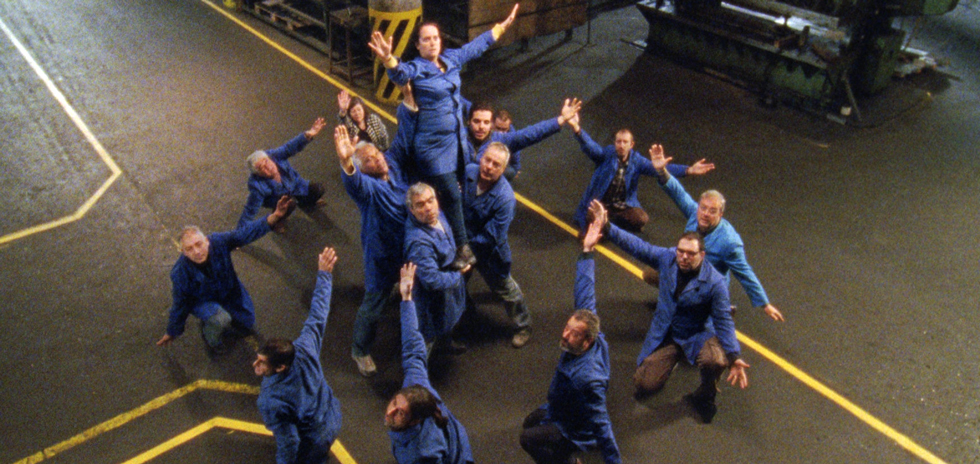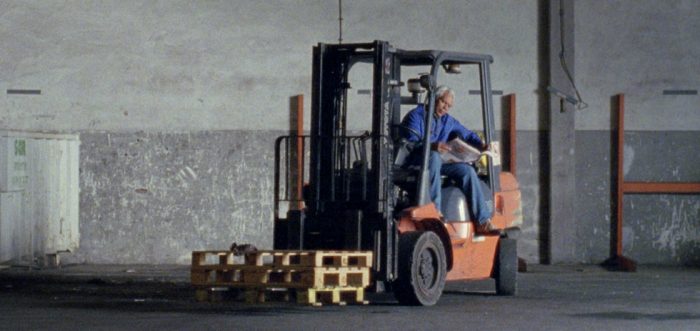
Early on in The Nothing Factory, a montage of drive-by shots of decrepit factories is accompanied by the disembodied voice of one of the film’s characters, solemnly intoning on the soundtrack, “a spectre is haunting Europe. The spectre of its ending.” Portuguese documentary filmmaker Pedro Pinho’s narrative debut makes its position clear from its very first shots, in which excavators tear down a water tank, the shrieking of metal being stripped on the soundtrack. Pinho cuts to the process of metal being pressed in the factory, making explicit the film’s essential premise – the link between overproduction and waste, and the consequences once this process becomes terminally unsustainable.
The film contains its capitalist critique to a Lisbon lift factory that is being wound down by management. Mass redundancies are sold as “readjustments” and an “opportunity to make the team stronger”. Machine operator Zé (José Smith Vargas) is the closest thing the film has to a protagonist: we are given intermittent access to his home life with Carla (Carla Galvão). In one scene, Carla is paid a visit by the factory’s HR representative while at her job as a beautician – her occupation suggests that class divisions remain rigid in the post-industrialising economy, which retains a market for manicures, if not manufacturing. And while Zé stands in as something of an everyman point of identification, his collective of fellow workers goes largely undifferentiated, and stand in as cyphers for different reactions to the restructure process. The seeds of distrust are sown as factory employees are offered, and contemplate, severance packages, weighing up their material needs against their dignity. Other workers defy management’s clandestine removal of factory machinery, and continue to show up to work. This effective occupation of the “nothing factory” leads to scenes that put a new spin on the neorealist impulse to record “dead time”, as characters stand aimlessly at their workstations, and later, play games with bottle caps and ride pallet jacks like scooters through the factory’s walkways. These images are among the strongest in the film, effectively conveying the alienating effects of industrial labour, and its essential absurdity.
In its subject matter, The Nothing Factory recalls Groupe Dziga Vertov’s exploration of an industrial dispute, Tout va bien (1972). In a similar manoeuvre, The Nothing Factory introduces a left-wing documentary maker who thinks he has found his next project in the factory occupation (Daniele Incalcaterra, looking like a bedraggled Kubrick). For the most part, this character remains tangential to the workers’ attempts to install collective management of their factory; indeed, his main contribution to the film is a lengthy political diatribe over a dinner party. As The Nothing Factory nears the three-hour mark, it may begin to feel, depending on its viewers’ politics and patience, like being similarly trapped in the company of a similarly insistent guest.

Like Miguel Gomes’ Arabian Nights (2015), The Nothing Factory takes Portugal’s dire economic circumstance as its starting point . Also like Gomes’ film, it freely shifts stylistic registers, incorporating handheld, verite style sequences with more static camerawork in the factory. The use of 16mm shooting stock throughout adds some welcome grain to the visual look of the film, and the occasional inclusions of documentary interviews and montage sequence carry a charge in their disruptive power. But where Gomes segued from financial cataclysm to the fantastical, The Nothing Factory remains, for the most part, determinedly grounded in reality, with a few notable exceptions. The introduction of a distrustful ostrich is a rare, Herzogian intrusion. When the characters spontaneously burst into song late in the film, the mundanity of the surroundings suggest the everyday musical fantasy of Demy, but Pinho doesn’t really shoot or stage the musical sequence with that degree of inventiveness, giving the impression that the musical sequence has likely been assembled in the editing room, rather than being carefully choreographed.
Late in The Nothing Factory, one character asks “what now?”. In its own cerebral, didactic, unwieldy way, the film offers discourse and dialectics, but no clear pathway out of the slump. It is a film that is easier to admire for the scope of its ambition than it is to necessarily enjoy. Perhaps the best that can be said is that it is a conversation starter in troubled times, for audiences prepared to go the distance with it.
